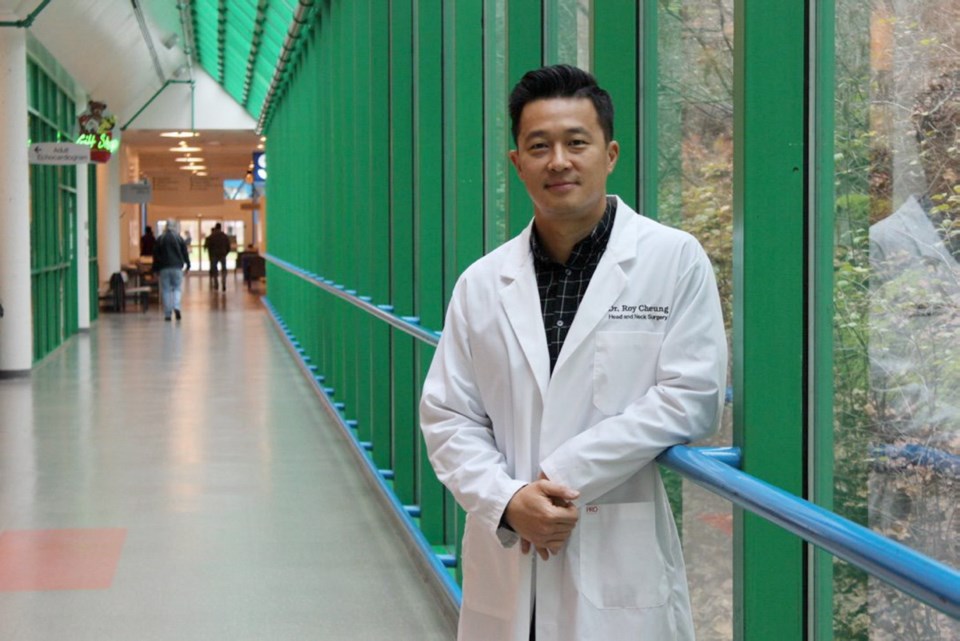University of Victoria biochemistry student Luke Neufeld got a rare look into his possible future professions after a Victoria surgeon saved his life.
It was late summer 2014 when a routine sinus infection abscessed. Neufeld’s eye was closing and his sight was impaired. He was in intense pain and was vomiting.
Antibiotics weren’t working. His father rushed him to the hospital.
“It was shocking,” Neufeld said. “I never experienced anything like that.
“As soon as they saw me at the hospital they decided it was pretty urgent.”
Dr. Roy Cheung, an ear, nose and throat surgeon specializing in head and neck oncology, saw the life-threatening signs.
“Once in a while, these acute sinusitis can be quite aggressive and cause complications — an abscess around the eye, or an abscess or a blood clot in the brain,” said Cheung. “It can happen within a day or two of the onset of sinusitis, and in his case, it happened.”
Victoria General Hospital saw several such cases last year, said Cheung. “It’s not uncommon.”
Cheung gathered other specialists, and Neufeld was rushed into after-hours surgery.
Sinus surgery is generally done through the nose. It’s a tricky part of the skull to deal with, considering the major vessels and the risk of damaging the eyes or brain.
Neufeld’s passages were inflamed, making surgery more challenging.
In Neufeld’s case, specialists took a CT scan and loaded the image onto what’s called an ENT image-guidance system.
Similar to the computerized map on a GPS system in a car, the map acts as a guide for the unique anatomy of the patient’s nose. The equipment includes a wireless headband worn by the patient to provide real-time reference points.
On another monitor are the images from an endoscope, which has a live video camera on one end and is fed through the patient’s nose to, in this case, find a safe passage. With the other hand, the surgeon entered the same nostril with tiny scissor-like tools, reached the abscess and drained it.
Neufeld made a complete recovery.
“I didn’t realize the expense of some of these operations — I thought it was more about medications and doctor’s time — but I now have a new appreciation for the [equipment] and all the fundraising that needs to go into making these surgeries possible. If they didn’t have this equipment, it would have been a totally different outcome,” he said.
“It certainly makes me more interested in being a doctor just because I have a better idea of what it’s all about,” said Neufeld. “I was shocked at how quickly it all progressed … and what a difference a doctor can make in a high-pressure situation.”
The ENT Image Guidance System is part of a $1.8-million fall fundraising campaign by the Victoria Hospitals Foundation for Royal Jubilee and Victoria General hospitals.
About two months ago, one machine was purchased for Victoria General, and the foundation is fundraising for that system and another planned for Royal Jubilee. The sole original machine that Victoria General had is “officially obsolete,” said Cheung.
“I believe it’s life-saving and vision-saving,” Cheung said of the equipment.
Most of the time, the equipment is used for sinus disease, but with a move toward more minimally invasive surgery, most growths — benign or cancerous — can also be also handled with endoscopic surgery and the assistance of the guidance system.
“In the old days we couldn’t get to those places that well,” Cheung said.
Cheung, practising 11 years in Victoria, performs tonsillectomies and reconstructive surgeries, and sees serious infections, but about 70 per cent of his practice involves
head and neck surgical oncology — tongue, throat, thyroid and increasingly HPV-related cancers.
For more information, call the foundation at 250-519-1750 or go to victoriahf.ca. Contributions can be made by donating online at victoriahf.ca, calling 250-519-1750 or mailing to Wilson Block, 1952 Bay St., Victoria, B.C., V8R 1J8.
[email protected]



